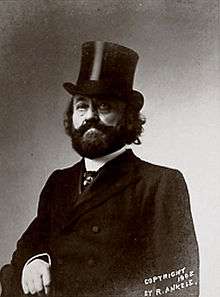Buatier De Kolta
Buatier de Kolta (né Joseph Buatier; Caluire-et-Cuire, 18 November 1845 – New Orleans, 7 October 1903) was a French magician who performed throughout the latter part of the 1800s in Europe and America.

Biography
Joseph Buatier was born in Caluire-et-Cuire (Rhône, France). His parents were fabric merchants. He started reading books on magic at age six, and as a teenager he was already performing in amateur magic shows in his school. However his father, a devout Catholic, wanted him to become a priest, and persuaded him to enter a seminary.[1] At age 18, he left it and worked as a painter, sharing a studio in Lyon with his more talented friend Elie-Joseph Laurent (1841–1926). He also resumed his performances as amateur magician, and one was noticed by Hungarian impresario Julius Vida de Kolta, who persuaded him to make magic his profession. His shows were immediately successful and he took the stage name Buatier de Kolta, acknowledging his debt to the impresario.[2]
In 1870, he started a European tour taking him to Italy, Germany, the Netherlands, and Spain, and was invited to perform at Jean-Eugène Robert-Houdin’s theatre in Paris. In 1874, he left Vida de Kolta and continued with a different impresario, who in 1875 took him to the Egyptian Hall in London and to Russia. In 1891, he went for his first tour to the United States. He started a second tour there in 1902, but died in New Orleans in 1903 of acute Bright's disease. He had married in 1879 a British woman, Alice Constance Mumford, who had him buried in London in the Hendon cemetery.[2]
De Kolta is the subject of the book Buatier de Kolta: Genius of Illusion by Peter Warlock. The city of Lyon named a street in the Quartier Le Vernay after him.[1]
Notable illusions
He was a contemporary of fellow French magician Jean Eugène Robert-Houdin. Many of his illusions, such as Multiplying balls, the Expanding Die, the Vanishing Lady, Spring Flowers from a Cone, and the vanishing bird cage, are performed by magicians today.[1]
It is the Vanishing Lady that is so particularly known today and still used that magicians now refer to it as the De Kolta Chair. A woman is seated on a chair, was then covered by a large cloth, and would appear to vanish before an audience. The effect was a signature piece of Richiardi Jr – after he vanished the woman she apparently reappeared moments later from an empty trunk on the other side of the stage.[2]
During his career, perhaps his most famous illusion was the one known as "The Expanding Dice."[1] A 200 mm-side dice on a table grew up to 800 mm and opened to reveal a young lady inside, who often was Buatier's wife. Harry Houdini purchased the dice after Buatier's death.[2]
References
- "Buatier de Kolta". Le Progrès. Lyon. 18 December 2017. Retrieved 23 January 2020.
- Warlock, Peter (1993). Buatier de Kolta: Genius of Illusion. Pasadena: Magical Publications. ISBN 978-0915181247.
Further reading
- Hay, Harry. Cyclopedia of Magic. (1949) ISBN 0-486-21808-2
- Warlock, Peter, Buatier de Kolta: Genius of Illusion (1993), Pasadena: Magical Publications ISBN 978-0915181247